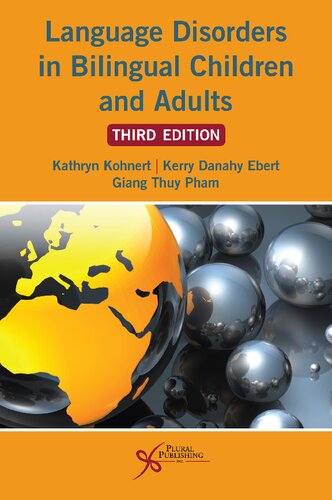

Most ebook files are in PDF format, so you can easily read them using various software such as Foxit Reader or directly on the Google Chrome browser.
Some ebook files are released by publishers in other formats such as .awz, .mobi, .epub, .fb2, etc. You may need to install specific software to read these formats on mobile/PC, such as Calibre.
Please read the tutorial at this link: https://ebookbell.com/faq
We offer FREE conversion to the popular formats you request; however, this may take some time. Therefore, right after payment, please email us, and we will try to provide the service as quickly as possible.
For some exceptional file formats or broken links (if any), please refrain from opening any disputes. Instead, email us first, and we will try to assist within a maximum of 6 hours.
EbookBell Team

5.0
88 reviews
In separate chapters, the book synthesizes the literature on bilingual children and adults with typical and atypical language skills. These chapters give the reader a deep understanding of the multiple factors that affect language development and disorders in those who rely on two languages for meaningful interactions. Chapters on assessment and intervention issues and methods are then presented for each population.
For children, the text focuses on developmental language disorder but also discusses secondary language disorders (such as autism spectrum disorder) in bilingual populations. For adults, the focus is on aphasia, with additional discussion of dementia, traumatic brain injury, and right hemisphere disorder. Although child and adult, typical and atypical populations are presented separately, all are considered within a unifying Dynamic Interactive Processing perspective and within a new Means-Opportunities-Motives framework for understanding language disorders in bilinguals. This broad theoretical framework emphasizes interactions between social, cognitive and communicative systems to form the basis for very practical implications related to assessment and intervention.
This third edition has been completely updated to reflect the current research on bilingual populations and the best practices for working with them. Studies at the intersection of bilingualism and language disorders have expanded to include additional disorders and new language combinations. The authors synthesize the current literature and translate it for clinical use.
Coauthors Kerry Danahy Ebert, PhD, CCC-SLP and Giang Pham, PhD, CCC-SLP
Updated literature review and references to reflect new research on bilingualism, cultural competence, cognitive advantages and clinical practice with linguistically diverse populations
Case studies on assessment with bilingual children and adults
Additional tables and figures summarizing key information
Available evidence on additional child and adult language disorders in bilinguals.
Updated extension activities and resource supplement.
A PluralPlus Companion Website with PowerPoint slides for instructors
With its updated content and new features, Language Disorders in Bilingual Children and Adults, Third Edition, is a must-have resource for any SLP who works with bilingual children or adults.